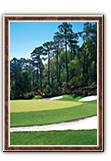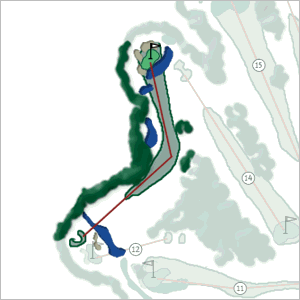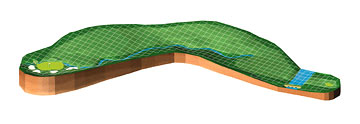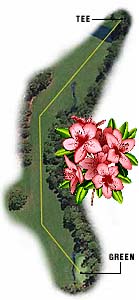| Hole Names | |
|
|
|

Hole #13Azaleagenus: Rhododendron Par 5, 485 Yards |

|
||
|
An accurate tee shot to the center of the fairway will allow a player to go for the green in two if he desires. A tributary to Rae's Creek winds in front of the green, and behind the putting surface are four bunkers. It is the location of the Byron Nelson Bridge. From tee to green there are approximately 1,600 azaleas. Rae's Creek runs along the left side of the fairway and crosses in front of the green. Can be reached in two. Hooked drive around the corner on dogleg left can set up mid-iron second shot. Rae's Creek runs along the left side of the fairway and crosses in front of the green. Can be reached in two. Best shape is a right-to-left drive around the corner that sets up a mid-iron for the second shot. Short for a par 5, but jealously guarded by a little creek that runs along the left side of the fairway before crossing just in front of the green and running past it to the right, barely off the putting surface. It can be reached in two by the long hitter with as little as a middle iron. | |||

QuickTime AVI (4.94M) Animated GIF | |||
|
Jack Nicklaus says: Shortest par-5 in all of major championship golf. It's not a par-5 length-wise but it certainly plays like one. One of my favorite holes in all of golf. You hit the ball at the two trees at the top of the hill with a slight draw. If you catch the hillside, you'll play a long- or middle-iron into the green. You want to make sure you keep the ball underneath the hole. The swale to the left of the green is not a place to be. Most of the fellows, they hit a good drive, should knock the ball on the green three of four times in the tournament. One of the shortest par 5s in major championship golf, No. 13 is also one of the gameís great natural holes. Itís certainly one of my favorites because it has been a catalyst to many of my best rounds. When I tied the old scoring record in 1965 with a third-round 64, the 13th was one of many big holes for me. I went out in 31, but didnít have any birdies from nine through 12. I got too excited over a five-foot birdie putt on 12 and missed it. I regained my momentum with a birdie at 13. Momentum can also reverse itself here. When I won my first Masters in 1963, I was paired with leader Mike Souchak in monsoon-like conditions during the third round. The fairway in the elbow of the dogleg appeared flooded. Mike thought we wouldnít be able to finish the round that day, that Augusta would cancel it. He went on to make a big number on that hole and finished with a 79. His mindset may have hurt him more than the conditions. Off the tee, I aim at the last two trees at the top of the fairway and draw the ball. I play for the center of the green on my second shot and never fiddle around with a flag tucked back left. If you are in contention here, youíve got to make birdie. Fuzzy Zoeller says: This is a dogleg left, but it's very difficult to hook the ball here. The fairway slopes severely right to left, and the creek is around the left side. You have to attack this hole, but the ball doesn't want to hook off that hill. The green isn't one of my favorites; there are too many mounds and moguls on it. The front right pin is the hardest. Tiger Woods says: It swings from right to left. They added some trees at the corner of the dogleg, making it more difficult for guys who hit the ball straight. They're penalized by going in the pine needles. It's wise to sweep it around the corner. If you can do that you're left with a mid-iron to the green. The problem is the ball is sitting above your feet, about mid-shin, and you have to hit a cut. Anything right is in the water, anything left is in the swales. You've got to try and hit that green. It has three different shelves. Fred Couples says: A hole I absolutely butchered a couple years ago when I was playing and was a couple shots behind. I'd bogeyed it three straight days and I turned it around the corner, had 6-iron to the green and I hit it in the water and bogeyed it for four rounds. I do hit 3-wood off the tee because you have to hit a patterned hook and not a hard hook. With a 3-wood I just send it out there and if it doesn't draw, I don't screw around with it. I lay up. A lot of players get sucked into going with a 2-iron or maybe a 4-wood, and, when you do, you can walk away with 6 very easily. Now I lay up. If I don't turn it around the corner, I've got an easy second shot when I lay up. If I have a 3-iron left, I might go for it, but a 2-iron or 3-wood isn't for me going to that green. The third shot is difficult because there are a bunch of tiers, but you can still get it up and have a shot at birdie. Bernhard Langer says: Off the tee here, I usually hit my driver. I know I can hook it and that makes the second shot a little easier. The ideal place to go for the green is from the left half of the fairway. If you come in from the right, you have a much smaller target. The hole is a favorite of many players, including me, and for good reason: It played as the easiest hole last year and produced the most birdies. Hole 13 has been very special for me in my two Masters victories. On Saturday in 1985, I was seven or eight shots back when I hit my tee shot near the pine trees on the right. I needed a 3-wood to get to the green but the ball was sitting down a bit. I was so far behind, I had to go for it. I caught the 3-wood thin and the ball hit short of Rae's Creek on that little upslope there, and it jumped over and onto the green. Then I made a 20-footer for eagle. In 1993's final round, Chip Beck hit a 4-wood to about 25 feet and I hit my 3-iron just inside him, almost on the same line. I saw what the ball did on the last six feet of his putt and that helped me make another eagle-just when it looked like I might tie the hole or even lose a stroke.
| |||

Hole #13Azaleagenus: Rhododendron This hole bears the name of the plant for which Augusta National is most noted. This Rhododendron specie may be seen in many forms on the course with over 30 varieties present. Native species and many of the rare older plants are also present. The flowering period will range from March to mid-April. From tee to green, this hole is flanked on its south side by a mass of azaleas which includes many different species and cultivars. |

|
||
fatpat Software · PO Box 1785 · Charlottesville, VA 22902 · (804) 977-1652
